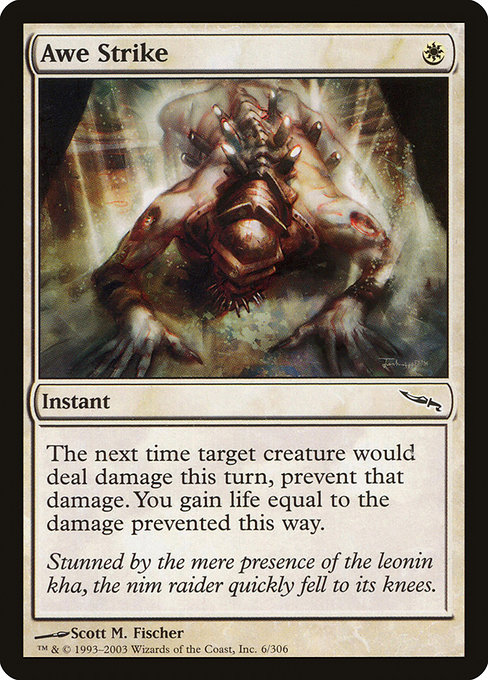
Image courtesy of Scryfall.com
When Design Chaos Mirrors Human Behavior
Magic: The Gathering isn’t just a battle of spells; it’s a mirror held up to how we humans think under pressure. The tiniest design choices—timing windows, cost, and the way effects scale with what actually happens—reveal a lot about our cognitive quirks. Awe Strike, a modest white instant from the Mirrodin era, is a compact classroom for these ideas. Its text is spare, its payoff is clean, and its impact on the table hums with the kind of predictable unpredictability that keeps players coming back for more 🧙♂️🔥.
The next time target creature would deal damage this turn, prevent that damage. You gain life equal to the damage prevented this way.
At first glance, Awe Strike looks like a straightforward shield—a single mana, instant-speed insurance policy. But the magic happens in the timing. The clause “the next time target creature would deal damage this turn” creates a fragile forecast. You must anticipate the board’s next swing, weigh the value of halting a single instance of damage, and decide whether the lifegain will prove decisive. That moment of decision—to pull the trigger now or hold the shield for a bigger threat—is a tiny study in risk tolerance. Our brains love patterns and predictable outcomes, yet we’re drawn to moments where a single card can tilt a moment-to-moment calculus from chaos to control 🧠🎲.
From a design perspective, the card sits squarely in white’s wheelhouse: damage prevention paired with life gain. It’s a common rarity, accessible to many decks, which makes the behavior it elicits broader and more democratic. The lifegain payoff reinforces a bias liberals often lean on: mitigating harm now can pave a path to endurance later. In a meta where a single blow can decide a game, Awe Strike offers a whisper of hope—an elegant reminder that defensive maneuvers can be just as strategic as a flashy finisher. The flavor text, “Stunned by the mere presence of the leonin kha, the nim raider quickly fell to its knees,” casts a scene of humility before a moment of awe-inspiring restraint, grounding the card in Mirrodin’s metallic, artifact-rich world 💎⚔️.
Design Chaos as a Social Experiment
Humans wrestle with the idea of “worth it” in every transaction, and Awe Strike encodes that negotiation in a single line. The card forces players to answer questions like: Is preventing damage worth potentially missing out on more lethal combat tricks? Will lifegain in a single moment alter a long arc toward stabilization or victory? The social dynamic at the table—reading opponents’ tells, predicting whether they’ll throw a big attacker, and deciding whether to protect a creature or save your life total—unfolds in real time. This is design chaos in motion: a rule-set constraint that spirals into human storytelling, strategic psychology, and even a bit of theater as players narrate the moment they chose protection over aggression 🧙♂️🎨.
And there’s a subtle study of value and scarcity baked in. Awe Strike’s white mana cost keeps the spell accessible, so it can appear in a wide array of decks, yet the decision to cast it lies in that delicate balance between what the board needs now and what you might lose if you wait a turn. The art and rules combine to create a tiny, reproducible scenario where players practice patience, calibration, and timing—skills that translate beyond the table into everyday life, especially when decisions hinge on imperfect information and evolving risk assessments 🧭💡.
Lessons Beyond the Battlefield
What design chaos teaches us about human behavior is not limited to MTG strategy. We learn that people crave control, yet often overvalue moments of safety as the clock ticks down. Awe Strike embodies a paradox: the simplest spells can prompt the most intricate human choices. The thrill comes not from dramatic fireworks but from the quiet satisfaction of a well-timed life swing—the kind that makes a mid-game lull feel like a comeback, and a comeback feel earned rather than handed to you on a silver platter 🎯💎.
For collectors and players, the card’s tactile history also matters. A common rarity with a classic white identity sits comfortably in the card catalog of Mirrodin’s era, a reminder of a time when artifact-themed power was intertwined with fundamental teachings about tempo, life as a resource, and the art of saying no to aggression just long enough to survive. The Scott M. Fischer illustration, crisp in its linework, anchors the spell in a world where metallic intrigue and human cunning collide—a perfect microcosm of how design chaos reveals our deepest tendencies 🖼️🧿.
Practical Takeaways for Your Next Game Night
- Use Awe Strike as a tempo tool when you expect a big attack or when you’re trying to stabilize a board state without trading your entire team.
- Pair it with lifegain triggers or other prevention-first effects to maximize the value of “the damage prevented this way.”
- Think about timing windows beyond the current turn; a well-timed shield can alter the opponent’s plan in subsequent plays, shaping how both players approach risk from that point forward.
If you’re a fan of bridging the physical and the digital, a small nod to MTG lore can travel with you anywhere. Speaking of carrying MTG spirit into daily life, consider this stylish companion for your phone: the product below keeps a card close—perfect for a quick thematic mood during your commute or tournament day. phone case with card holder magsafe polycarbonate gift packaging 🧙♂️
More from our network
- https://blog.digital-vault.xyz/blog/post/origins-of-dreadbringer-lampads-set-lore-and-context/
- https://blog.digital-vault.xyz/blog/post/clustering-mtg-cards-by-mechanics-valleymaker-edition/
- https://blog.digital-vault.xyz/blog/post/clustering-soltari-lancer-with-similar-mechanics/
- https://crypto-acolytes.xyz/blog/post/csgo-vs-cs2-which-is-the-better-competitive-shooter/
- https://blog.digital-vault.xyz/blog/post/geths-verdict-unraveling-phyrexian-origins-and-set-lore/